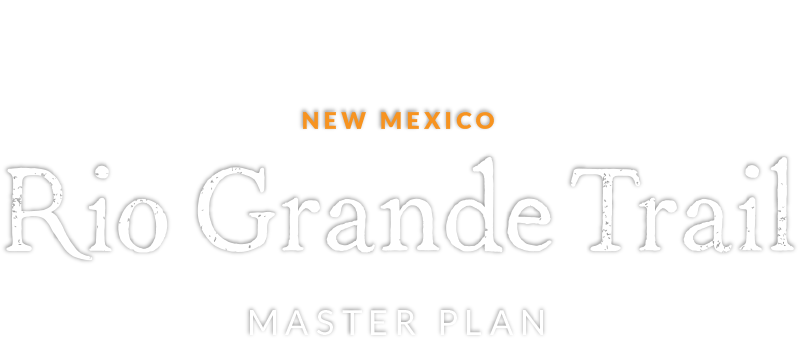Connecting the Rockies to the Chihuahuan Desert
The Rio Grande Trail alignment spans over 500 miles, and it travels through the unforgettable landscapes of New Mexico from Colorado to Texas. The trail connects from the Rockies in the north to the Chihuahuan Desert in the south through some of the oldest living communities of North America and along a well-worn path traveled for more than a thousand years.
The trail’s vision is to have a continuous alignment through New Mexico with a focus on non-motorized trail users. It allows users to explore, learn about, and connect with a tapestry of diverse natural habitats, rich history, striking landscapes, and vibrant communities. The trail contributes to cultural and environmental awareness, healthy lifestyles, spiritual growth, and economic prosperity for New Mexico and its visitors.
The river is one of North America’s longest rivers, spanning over 1,900 miles from its headwaters in the San Juan Mountains in southern Colorado to where it meets the sea in the Gulf of Mexico. The Rio Grande is not merely a geographical feature but a source of inspiration, a symbol of continuity that connects generations. Its ancient banks have witnessed the ebb and flow of time, standing as silent witnesses to the rich tapestry of human history etched into the New Mexican soil.
The Rio Grande Trail, a path of environmental significance, follows this extraordinary journey through mountains and desert landscapes, passing through important ecological systems, wildlife refuges, monuments, and heritage areas. This landscape, the ancestral homelands of many, is the lifeline for cultures and communities and is an irreplaceable natural resource providing habitat to rare aquatic and riparian habitats found nowhere else.
As the central artery of New Mexico for all of its recorded history, the Rio Grande corridor has been a priority route and a well-worn path for more than a thousand years.
We invite you to explore the trail, the magnificent landscapes, and the cultures it passes. Like many long-distance trails, the Rio Grande Trail is developing in constant motion. To explore, travel, and experience the Trail, visit the trail map.

Rio Grande Trail Alignment Map
Trail Development – One Step at a Time
There are over 100 miles of designated trail segments. All designated trail segments follow an underlying trail suitable for different user groups. For example, many of the miles designated in Taos County are dirt trails, while those designated in the City of Albuquerque follow a paved multi-use trail. The undeveloped trail segments either follow existing roadways or, in many cases, are planned trails, but at present, only lines on a map.
Since 2022, the Outdoor Recreation Division (ORD) has been working with a consultant to implement more trail segments and help communities identify the next steps to completing the Rio Grande Trail. One crucial step is the official designation of the trail. The designation process creates a process to identify and designate the responsibilities of trail landowners, and managers record those.
In order to become part of the Rio Grande Trail network, trail segments must be approved through an official designation process. Previously constructed trail segments that meet the criteria established in the Master Plan (see link above) may be designated by completing and submitting a Trail Segment Designation Application form. This form can also be completed for entities looking to design or construct a new trail segment.
Submitted applications will be reviewed by the Rio Grande Trail Commission for approval on a quarterly basis, at regularly scheduled Commission meetings. In all cases, the hired consultant team will support all applicants in their endeavors. For more information email Katrina Arndt Karndt@mrwmla.com.
In pursuit of the Vision captured in New Mexico’s Rio Grande Trail (RGT) Master Plan, landowners, land managers, and/or other jurisdictional entities are encouraged to develop trail segments that will contribute toward ultimate completion of a continuous statewide recreational facility. We hired a consultant team to facilitate this effort, with stakeholders willing to participate in this voluntary process.
The Rio Grande Trail network is intended to include both a continuous Primary Alignment that follows the Rio Grande as closely as possible, extending from Colorado to Texas and Secondary or Connector alignments that provide links from the Primary trail to nearby communities or points of interest.
Some obstacles to a continuous river alignment will be encountered due to sovereignty concerns, physical impasses, or other matters. In those cases – many of which are already reflected in the preferred alignments identified in the Master Plan Appendices – alternate alignments will be considered, which may carry the trail many miles from the Rio Grande itself. In these cases, continuity will take priority over proximity to the river. It is also acknowledged that other alignment opportunities may exist that have not yet been identified but would be considered on a case-by-case basis.
As part of the Rio Grande Trail implementation efforts, a consultant team is working with communities, landowners, and other agencies to implement and designate sections of the trail. This project website will be updated throughout the process.



